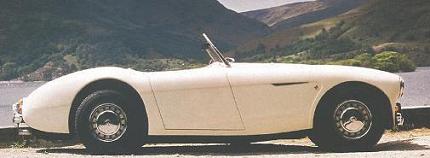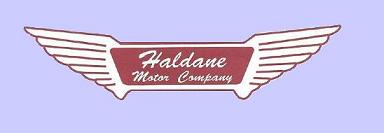
Engine.
The engine in this car is a 2 litre 4-cylinder Ford engine from a Capri, Taunus, Granada, Sierra, Transit, Escort.
It has a single overhead camshaft (OHC) and is also called the Pinto engine because in America this engine was used
in the Ford Pinto. This engine was also nicknamed the "Metric engine" because it was designed to the metric system.
This engine was also referred to as the Taunus in Line or Lima in Line. More information on this engine is widely
available on the internet.
There was a low compression variant and a high compression variant. In my case when fitted with the Weber DGAV32/36 carburettor
it should be mated with the high compression variant and produces nearly 100 bhp as is.
The engine in this car is equipped with a "normal" ignition (contactbreaker, condensor and coil). I can work with
these engines. Anything newer with electronic shit and ECU modules is totally beyond me, so this is fine!
On the engine block the number 20 is part of the casing and this indicates it is a 2000 cc engine.
Because I wanted to fit a 5-speed gearbox I removed the engine and I will give it a clean, a checkup and new
oil and oilfilter. Maybe I will also renew the clutch, pressure plate, clutch bearing, belts, waterpump and thermostat.
Now that it is all accessible I might as well do that. It is quite remarkable that when dismantling items on this car I found
that a lot of bolts were not tightened at all. So only because of this I am already pleased to have done it.


Ford Pinto 2.0 OHC engine on the bench.
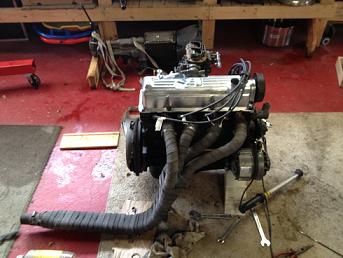

The engine has been cleaned, new oil and oilfilter. I wrapped the exhaust manifold with heat insulation cloth. I also made a new airfilter myself.
The standard airfilter was very large and I didn't like the look of the thing. I bought a round airfilter from a Sierra and made an oval casing for it.
I removed all brackets from the valve cover. I will fit a dust shield, this is a plate that should be fitted between engine and gearbox and protects an
otherwise exposed flywheel, clutch and bearing.
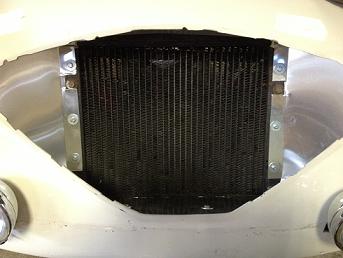
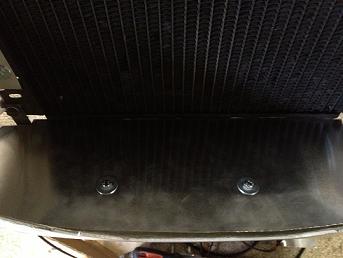
For the radiator I made a "cowl" of aluminium plate to make sure all the air will pass through the radiator.
There was one, unexpected, problem when I put the engine back in. Because the steering column was moved to the left
in the engine bay the mechanical fuel pump could not be fitted anymore.... I quickly came to the conclusion that I had to fit
an electrical fuel pump.
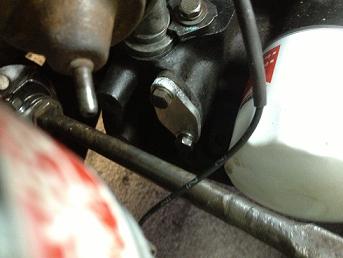
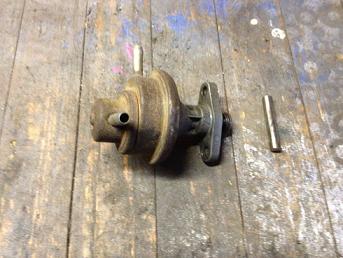
I blanked off the engine block where the mechanical pump should be fitted (do not
forget to also remove the plunger).
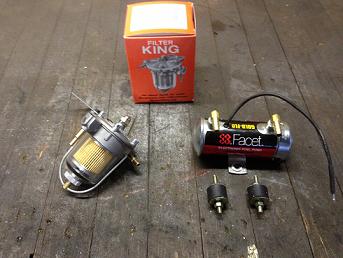
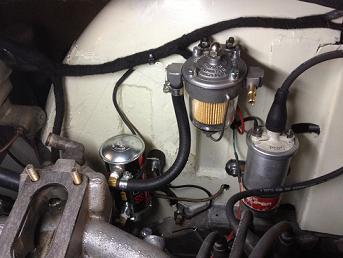
I bought a Facet fuel pump with enough suction power so that it could be mounted in the engine bay. Then someone
told me that I would also need a pressure regulator. These items have been mounted inside the engine bay.
Engine bay cleaned up.
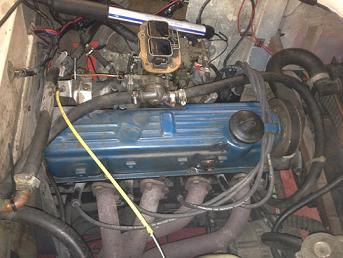

Before and after.
Gearbox.
This car came with a 4-speed gearbox mated to a Ford Sierra 2000 cc engine (Pinto engine, 2.0 OHC). I knew
a 5-speed gearbox was also available for this engine. Because of the extra fifth gear the revs that the
engine makes on the highway will be reduced with somewhere between 500 - 800 rpm. This will then feel more
relaxed and gives less stress for the engine.
I did some research on the internet. Apparently Ford Sierra's were equipped with the T9 gearbox from the start
in 1983 and in 1988 was replaced with the MT75 gearbox (and DOHC engines). The T9 gearbox will bolt directly to the 2.0 ohc Pinto engine.
The MT75 will not fit without modifications. The T9 gearbox was also available as a 4-speed gearbox (Rocket E) and when mated to
a V6 Ford engine has a different bellhousing and (longer) input shaft. When the gearbox is placed right up on its bellhousing
and stands firm on the ground it is a gearbox for a 4-cylinder engine. If the gearbox balances on its input shaft then
it is a gearbox for the V6 engines. I was told that the T9N gearbox is always a 5-speed, 4 speed T9 gearboxes are T9A
(4-speed fixed bellhousing), T9B (4-speed, usually separate bellhousing) and T9C (4-speed separate bellhousing). For a good
explanation of these gearboxes I would recommend www.BurtonPower.com and the Ford Sierra Haynes manual.
I tried to find a used T9N gearbox and I could even pick one not far from where I live. The gearbox was inspected,
cleaned and is now ready to be placed into my car. This will be combined with the rebuild of the front suspension and the
conversion to left hand drive.
I noticed that this gearbox has a bellhousing with the starter motor on the right. My car currently has a bellhousing were the starter motor
can be mounted on the left. Starter motor is therefore currently mounted on the left. The clutch cable in its turn is mounted on the right.
Maybe I will have to swap bellhousings. We will see when the gearbox comes out.
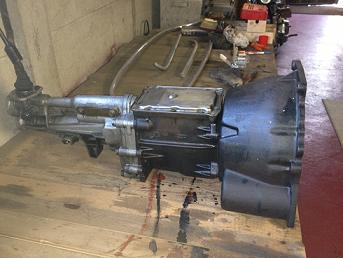
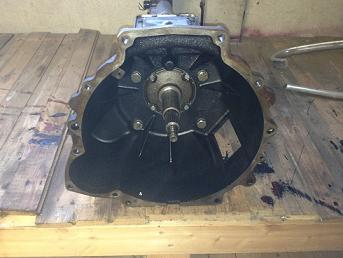
Today (19 january 2013) I started removing engine and gearbox. First the carburettor and inlet manifold came off, followed by alternator, starter
motor, exhaust manifold, distributor, fuel pump, radiator and fan. Engine mounts and bellhousing bolts. Engine out.
Gearbox central bolt and gearstick. Gearbox forwarded and speedo cable out. Gearbox out.


Pff... I was pleased to see that the old 4-speed gearbox was of exact dimensions as the 5-speed box. Same location for the central bolt and gear stick.
The same input and output shaft, splines, length and diameter. The new gearbox will fit without too many consequences.
Correction: the location for the central bolt is NOT in the same location. I will have to put the mouting point further back on the chassis.
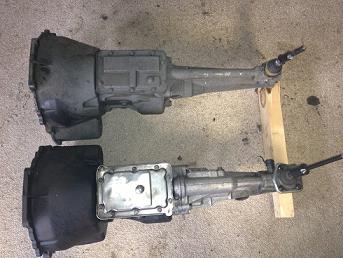
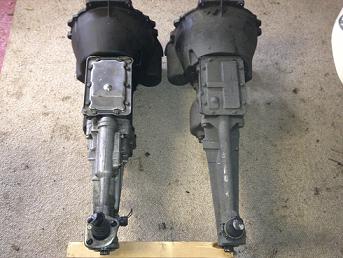
I will use the 5-speed box with the bellhousing it came with. This will mean starter motor on the right and clutch cable on the left. If I would use the
other bellhousing I would need a very long clutch cable because I will convert from right hand drive to left hand drive. The clutch arm should be near
the clutch pedal in order to maintain a "normal length" clutch cable. I will, however, need to trial-fit to see if the exhaust manifold will not foul the
starter motor. The exhaust manifold is a tubular steel type and not the original cast manifold.

Exhaust manifold and propshaft on the bench. Because front suspension, engine, gearbox, pedals and steering column were all removed my garage looks like
a bomb has exploded. Time to sort it all out first.
To be continued....
Clutch.
My Haldane is in the process of being converted to left hand drive. One of the tasks was to move the startermotor to
the right-hand side so the clutchcable went to the left-hand side. The clutch pedal is to the very left and that would
mean an awkward bend in the clutch cable to clear the inner wing. I also didn't like the startermotor to be very close
to the exhaust. I decided to convert to hydraulic clutch.
I bought a good second-hand clutch master and slave cylinder for next to nothing. I had a spare brake pedal from an Opel
Kadett which I adapted for the clutch master cylinder. The existing clutch pedal was to pull for a cable (cable connected above
pivot point of pedal) and should be push (connection below pivot point of pedal).
The slave cylinder was mounted to the gearbox by drilling three holes in the bellhouse and fabricating a sturdy bracket for the slave cylinder.
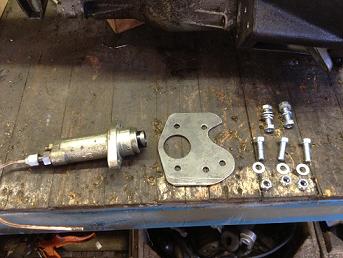

Slave cylinder from Landrover Defender, bracket and bolts.
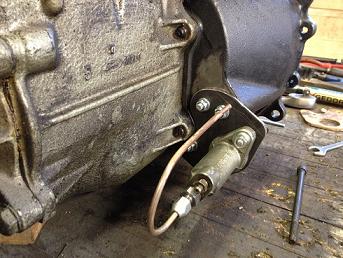
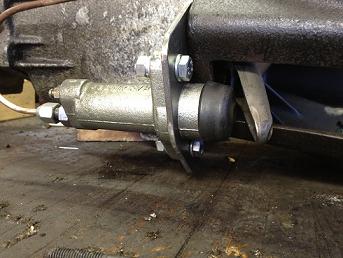
Slave cylinder mounted to gearbox.
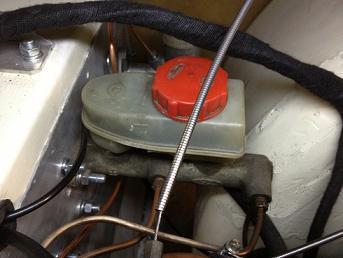
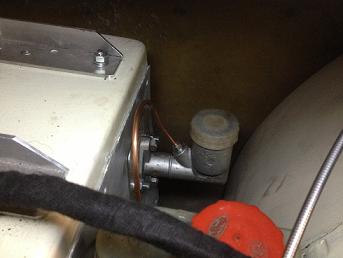
I installed a left hand drive brake master cylinder. This so I had the brake pipes connected on the right side and not on the side where accessibility is poor.
Clutch master cylinder also mounted... Clutch master and slave are from a Landrover Defender.
